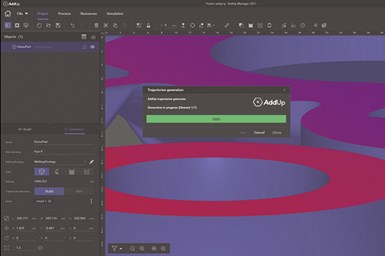AddUp Trajectory Generator Offers Faster Slicing, Scanning Computations
Fast slice and toolpath generator offers smooth upskins and downskins to obtain superior part surface quality.
Share
Read Next

The AddUp Trajectory Generator computes about 22 million vectors in 17.3 seconds (8 Cores CPU @2.80 GHz).
AddUp’s latest version of its Trajectory Generator for its FormUp metal 3D printer features advanced algorithms that offer slicing and toolpathing performance, the company says. The program was developed in partnership with Inria (Institut national de recherche en sciences et technologies du numérique), the computer graphics experts behind IceSL, a highly efficient hybrid CPU-GPU slicer.
The AddUp Trajectory Generator is a fast slice and toolpath generator that offers smooth upskins and downskins to obtain superior part surface quality. The feature strengthens the existing list of operations available for visual strategy trees, which is a unique approach for AM strategies creation, according to the company.
The slicing and scanning trajectory computation speed is around 1,000 times the build speed of these trajectories, the company says. This performance is achieved through innovative algorithms and efficient parallelization on multi-core CPUs, which do not require specific vendor hardware. Also, slicing performance scales naturally with the number of CPU cores — from home laptops to many-core desktop CPUs. The slicer is designed to make the best use of the target platform capabilities.
Thanks to the visual strategy tree definition, users are given unlimited combinations of operations and parameters, while no programming skills are needed. With such a rapid learning curve, customers can be focused on production from day one, the company says. AddUp Trajectory Generator is included in the AddUp Manager 2021 manufacturing preparation software.
Related Content
-
With Electrochemical Additive Manufacturing (ECAM), Cooling Technology Is Advancing by Degrees
San Diego-based Fabric8Labs is applying electroplating chemistries and DLP-style machines to 3D print cold plates for the semiconductor industry in pure copper. These complex geometries combined with the rise of liquid cooling systems promise significant improvements for thermal management.
-
3D Printed Titanium Replaces Aluminum for Unmanned Aircraft Wing Splice: The Cool Parts Show #72
Rapid Plasma Deposition produces the near-net-shape preform for a newly designed wing splice for remotely piloted aircraft from General Atomics. The Cool Parts Show visits Norsk Titanium, where this part is made.
-
3D Printed Cutting Tool for Large Transmission Part: The Cool Parts Show Bonus
A boring tool that was once 30 kg challenged the performance of the machining center using it. The replacement tool is 11.5 kg, and more efficient as well, thanks to generative design.










